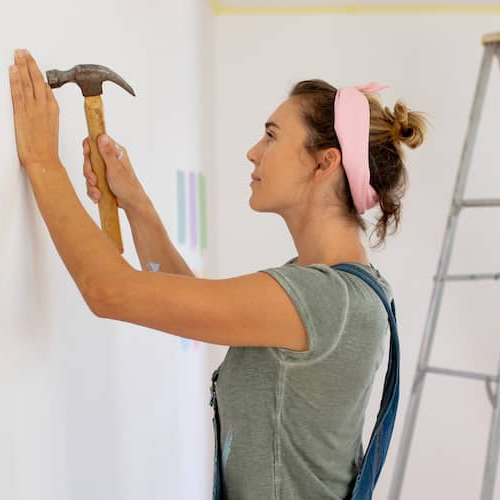Cheapest ways to build a house: 12 tips for affordable home building
Mar 15, 2024
•7-minute read

If you live in a part of the U.S. where housing isn’t as affordable as it is in other places, you may be looking for the cheapest way to build a house instead of buying one. With so many cost-saving options available, building a budget-friendly home is doable in many cases.
The average cost to build a house in 2024 ranges from roughly $137,901 to $523,890. Building can be cheaper than buying an existing house if you make strategic choices regarding house size, building materials, floor plan and more. If you want to keep your building costs on the lower side, you can find plenty of ways to maintain a low budget for a new-construction home.
12 ideas to make building a house more affordable
So, what’s the cheapest way to build a house? If you’re looking for the most inexpensive ways to build a home, consider implementing one or more of the dozen tips discussed below.
1. Simplify your home’s layout
The cheapest way to build a home is to design a simple floor plan. Sticking to a square or rectangular floor plan makes the building and design more straightforward. Plus, building up is generally cheaper than building a sprawling one-story home. You may want to consider planning for a multiple-story home if you need more space.
2. Choose a simple roof design
Another part of the home’s design to consider is the roof. The cost of a new roof depends on factors such as the square footage of the house, the materials used, the number of pitches, the steepness of the slopes and length of the slopes. The simpler the roofing design, the less expensive it’ll be to build your own house.
The normal price range for installing a new roof is $5,855 to $13,116. Asphalt shingles, which are a more budget-friendly roofing option, can cost $2,000 – $4,000 for just the materials. If you’re looking for durability over affordability, roofing materials such as slate or stone can cost anywhere in the $5,800 – $30,000 range. Shop around to compare the costs of different roofing materials and styles before installing the best option for you.
3. Try a tiny home
Tiny houses cost less to build than more traditional houses and can be built on wheels, which offers the flexibility of moving the house with relative ease in the future. For these reasons in particular, tiny homes are increasing in popularity. Many of your materials and labor will be priced per square foot, so reducing the square footage of your dream home will naturally make materials and labor more affordable. These savings will be especially noticeable for a tiny home, which by definition is less than 400 square feet.
The average cost to build a tiny home is somewhere in the $30,000 to $60,000 range for materials. Depending on whether your tiny home is mobile or stationary, you may also have to buy land to build it on.
According to the United States Department of Agriculture (USDA), you’ll pay about $4,080 per acre for rural real estate. However, the cost of land will depend on factors such as the state you plan to live in and the land’s proximity to metropolitan areas. You may be able to find a campground or rental lot that’s more affordable than purchasing land. Also note: You typically can’t get a mortgage for a tiny home, so you’ll need to look at alternative financing options.
4. Consider the cheapest homes to build
Another low-cost way to build a house is to go with a nontraditional type of home. Alternative housing is often more affordable to build than a traditional single-family home. Along with tiny homes, here are some of the cheapest houses to build:
- Kit homes
- Barndominiums
- Ranch-style homes
- A-frame houses
- Modular homes
5. Hire an experienced home builder
If you’re working with a home builder, hire an experienced one. While a home builder with significant experience might cost more than one with little to no experience, it’ll be worth it during the building process.
An experienced builder can help you figure out where to spend and where to save. Plus, they can help you avoid problems since they’ve likely navigated a lot of home construction issues throughout their career.
6. Act as your own general contractor
If you have building experience or oversee a large network of skilled laborers, you may decide to act as your own contractor and manage the home building process yourself.
That said, it might be wise to use subcontractors for some work if this is your first time building a house. Correcting your mistakes can be costly and time-consuming. If you’re not sure of your skills, hiring a professional can save more money in the long run.
7. Get your design plans approved
Designing your home can cost a lot of time and money. If you don’t get your building permits approved in a timely fashion, for instance, the construction on your new house could be delayed. Any changes you make to your building plan during the construction process can also add to the total cost of the build.
Plus, if you start building the house without getting your plans approved by your city or county, you risk hefty fines (or worse, having to redo some of your already completed work). That’s why it’s important to get your plans approved early in the planning process before beginning construction.
8. Budget, plan and price out all items
Don’t wait until the end of your home build to be surprised by the cost. Create a budget and price out everything you expect to spend on your new home. While you may not have a perfect estimate at first, getting a handle on the building costs can help you throughout the process.
Whenever prices change or a cost gets added, put it into your budget – which should be a live document that changes as your plans change so you always know where you are in your spending and don’t go over your budget.
If you’re using a construction loan or another type of financing, you’ll need to have a cost breakdown anyway. When you apply for mortgage preapproval, your lender will likely want to see how much you plan to spend on each step of the project. For that reason, it’s a good idea to have at least a rough budget before you start construction.
9. Choose building materials wisely
Choosing cost-effective materials can help keep the project more affordable and within budget. Here are a few types of building materials to consider for your home’s construction.
Reclaimed materials
Using reclaimed materials such as old barn doors or wood isn’t only trendy, but it can also save you money. Look for reclaimed doors, wood floors, windows and decorative items when planning the design of your house.
Not sure where to find reclaimed materials? Check Craigslist, Planet Reuse or a salvage store. You may even be able to find a home being torn down and salvage some of its old materials.
Prefab panels
Prefabricated panels are wall panels that are custom-built inside a factory and shipped to the build site. Having the walls built indoors and shipped to the site ready to install can cut down on any required construction. Plus, it can reduce the time spent on framing and drywalling.
Opting for prefab panels can also help you save money because you aren’t paying for the extra labor costs to build and frame the walls. Just make sure you have the appropriate building permits before constructing any prefab housing.
Precast concrete
Precast concrete is poured into a reusable mold, cured indoors and then shipped to the build site. Typically, precast concrete costs less than on-site pouring because it cuts down on on-site labor and can help prevent delays due to the weather.
Shipping containers
This alternative housing option uses old shipping containers for the structure of the home. Since the structure is already intact, this type of housing can help you save money on construction costs.
Consider the modifications you’ll need to make to the container to turn it into a usable living space. Costs can also go up if you need more than one container to create your shipping container home.
Cob
Cob is a mixture of straw, clay and subsoil. This earthen material is so thick that it provides thermal, energy-efficient benefits. Since most of the ingredients for cob can be found on-site for free, you can save a good amount of money on material costs.
Cob is also known to last hundreds of years and only requires a new layer when it inevitably needs to be fixed. This makes it a great building material for a cheap house.
10. Buy materials at a discount
Materials are one of the biggest costs of building a home. Reducing the cost of materials can significantly lower the total cost required to build your own home. When you begin shopping, consider asking each supplier if they offer a builder’s discount. If you’re constructing the house yourself, you may qualify for a discount on your building materials.
Your contractor might likewise be able to acquire any necessary building materials at a discount.
11. Add energy-efficient home features for rebates and taxes
If you’re interested in creating an energy-efficient home, going this route should reduce your carbon footprint and save money in the long run. Using energy-efficient materials, including better insulation and high-efficiency windows, will likely cost more upfront but ultimately enable homeowners to save money over the years.
Consider solar panels or wind energy as a power source for your property. Check to ensure these are available in your area and are the best option for your particular piece of land.
You might also be able to qualify for rebates and tax breaks for building certain energy-efficient elements into your home. Visit EnergyStar.gov to search for local, state and federal rebates for your energy projects.
12. DIY as much as possible
Are there certain finishes you’d love to have in your home but can’t afford? Consider doing some research and taking on some projects yourself to cut down on professional labor costs. The do-it-yourself (DIY) approach can save you money, especially with projects – such as painting or laying flooring – that you may not need a licensed contractor for.
Keep in mind that not all work you DIY will be a money-saver. If you don’t know how to perform some of the big jobs, such as plumbing or electrical tasks, it may cost you more to have someone fix your mistakes down the road.
The bottom line: Building your own house can save money, but it presents challenges
Home building can be a financially viable alternative if you’re thinking of buying a house but are limited by a tight budget. However, taking the more straightforward path of buying a preexisting home offers some clear advantages. Although you might miss out on some opportunities to save, you can avoid building costs and the unpredictability they bring.
Before deciding to build, learn more about financing the construction costs. Rocket Mortgage® doesn’t offer construction loans at this time.
If building a home sounds too complicated, an existing home might be your best option. Fill out a mortgage application with Rocket Mortgage to see how you qualify.

Erica Gellerman
Erica Gellerman is a CPA, MBA, personal finance writer, and founder of The Worth Project. Her work has been featured on Forbes, Money, Business Insider, The Everygirl, The Everymom and more.
Related resources

6-minute read
The pros and cons of buying a house
The more you know about the pros and cons of buying a house, the easier it’ll be to make the right decision for you. Check out our guide to learn more....
Read more
6-minute read
10 best places to build a house during the 2021 building boom
Are you interested in building a house on a budget? Learn about the 10 cheapest places to build a house in 2023 and other factors to consider when building.
Read more
8-minute read
Site-built homes: What you need to know
Site-built homes are constructed entirely at their final location. Discover how these homes are built, their cost, your financing options and the timeline.
Read more